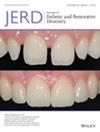Interdisciplinary Approach to Retreatment of a Full-Mouth Rehabilitation: Horizontal Preparations, Vertical Dimension of Occlusion Increase, and Mucogingival Surgery in a Tetracycline-Stained Dentition
Abstract
Objective
This case report presents the interdisciplinary retreatment of a patient with a worn full-mouth rehabilitation using defect-oriented restorations, horizontal preparations, and vertical dimension of occlusion (VDO) increase.
Clinical Considerations
A 58-year-old woman with a previous full-mouth rehabilitation presented with worn dentition, loss of VDO, and reduced posterior support. Examination revealed signs of parafunctional habits, tetracycline-stained teeth, and compromised aesthetics with exposed discolored teeth and open embrasure spaces. Additionally, the veneers showed wear and ceramic chipping. The retreatment started with a diagnostic phase, including a wax-up and mock-up to guide the treatment plan. Mucogingival surgery was performed to correct gingival recession according to the restorative margins established by the mock-up. The full-mouth rehabilitation involved increasing the VDO through anterior crowns and veneers, posterior overlays, and dental implant restoration. Horizontal chamfer preparations ensured sufficient thickness for the ceramic material, allowing for durable adhesive restorations.
Conclusions
The interdisciplinary approach, combining diagnostic, surgical, and prosthetic phases, enabled the successful retreatment of this complex case, restoring function and aesthetics. A 2-year follow-up confirmed the stability and positive outcomes of the rehabilitated dentition.
Clinical Significance
This interdisciplinary approach provides an effective strategy for managing complex full-mouth rehabilitations, integrating aesthetics, function, and periodontal health through defect-oriented preparation techniques.

 求助内容:
求助内容: 应助结果提醒方式:
应助结果提醒方式:


